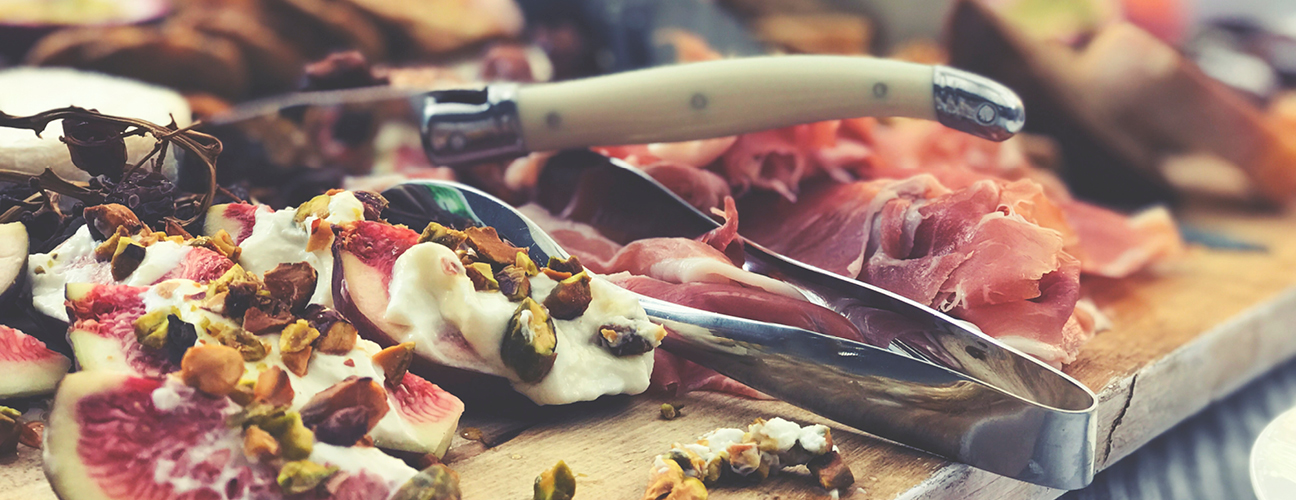Why the grazing board is your summer entertaining solution

With the summer entertaining season in full swing, the grazing board comes into its own as the perfect solution for a drinks party, pre-dinner nibbles or even dessert. Read on to learn the tricks of making yours stylish and delicious.
People coming over? No time to prepare fiddly canapes, starters or dessert? “Cheese and nibbles” has evolved somewhat over recent years and grazing boards have become the thing to serve. Why? Because they’re easy, they look great and there’s something for everyone.
First – the board
A large wooden bread board of course is ideal but think (literally) outside the square – a left-over plank or wooden offcut, a repurposed piece of shelving, a piece of flat stone or marble will all work – just make sure they’re not treated and are food-safe. If you are feeding a number of people a long rectangular board that runs lengthwise along your table or bench works best so several people graze the board at the same time.
Choose and place your hero elements
Your main ingredients will form the structure of your grazing board. Depending on your theme – your grazing board might be antipasto, fruit and cheese, or desserts – place your hero elements along the board in regular intervals, evenly spaced.
For a fruit and cheese grazing board, this would be three to five different types of cheeses - say, a hard cheese (for example a Cheddar or a Comte), a soft cheese (perhaps a Camembert or Brie), a blue (try a Stilton, Roquefort, Gorgonzola or Saint Augur), a soft sheep or goat cheese (try a good quality sheep’s Feta or Chevre) and maybe a semi-hard cheese (think Gruyere, Emmental, Manchego, or Tallegio). Place them along your board in a staggered or linear way leaving space in between each cheese.
On an antipasto board, these might include your sliced meats (Italian prosciutto, a good salami, some hand cut ham off the bone), or several dips or patés decanted into small bowls or ramekins and placed along the board.
Secondary elements
Next place your secondary elements. On a cheese grazing board this will be large bunches of red or green grapes, a few punnets of tumbled strawberries, blueberries and raspberries, and a wedge or two of fruit paste. Fit these in between your main elements.
On an antipasto board, you might add piles of sundried tomatoes, caperberries, pepperdews stuffed with cream cheese, stuffed olives, pickled octopus, artichokes or any other type of antipasto you enjoy. If some of these are oily or briny, you can put them in small bowls and fit them between your main elements. The bowls don’t have to match and will add interest and dimension to your board.
Add your crackers, nuts, vegetables or dried fruit
Into all the gaps between your main and secondary elements, add whatever your guests will need to accompany the main elements. For cheese platters this will be crackers, dried fruits, nuts, and pretzels. For an antipasto board, slices of baguettes and crackers, and if you have included dips, some julienned carrots and cucumbers, and whole fresh green beans.
Add these in abundance, and don’t hold back! You basically want very little or no board showing through once you’re done. You are trying to achieve a generous, near-overflowing effect that will encourage your guests to keep on grazing.
Don’t forget to add a small container of toothpicks, cheese knives, palette knives for spreading dips or paté, and a small bowl for olive pits.
Greenery improves the scenery
Colour and presentation is important on a grazing platter. Try to include as many different coloured ingredients as you can. If you have a lot of red-coloured elements (cured meats, sundried tomatoes, pepperdews) balance this with green ones (green olives, green grapes, or a handful of rocket) to achieve a visually balanced effect.
Dessert anyone?
The above principles can be applied to a dessert grazing board too. These can look very decadent yet can be put together with very little effort.
Your main elements might include store-bought macarons in beautiful colours, mini-fruit tarts, mini-donuts and mini-meringues.
Then add your secondary elements – again piles of berries, grapes, fresh cherries if in season, and perhaps bowls of cinnamon-spiced yogurt and melted chocolate into which your guests can dip their fruit.
Finally fill in the gaps – gold-wrapped Ferrero Rochers look great as do the exquisite Cat’s Tongue or Lakker chocolates, some broken up chocolate honeycomb, store-bought chocolate Florentines and Persian fairyfloss.
All these ingredients and more are available from the deli, cheese and Home sections of your nearest Hill Street store, including wooden boards, cheese and palette knives, and small bowls. And of course, great advice from our specialist team members. Find your local Hill Street here.

